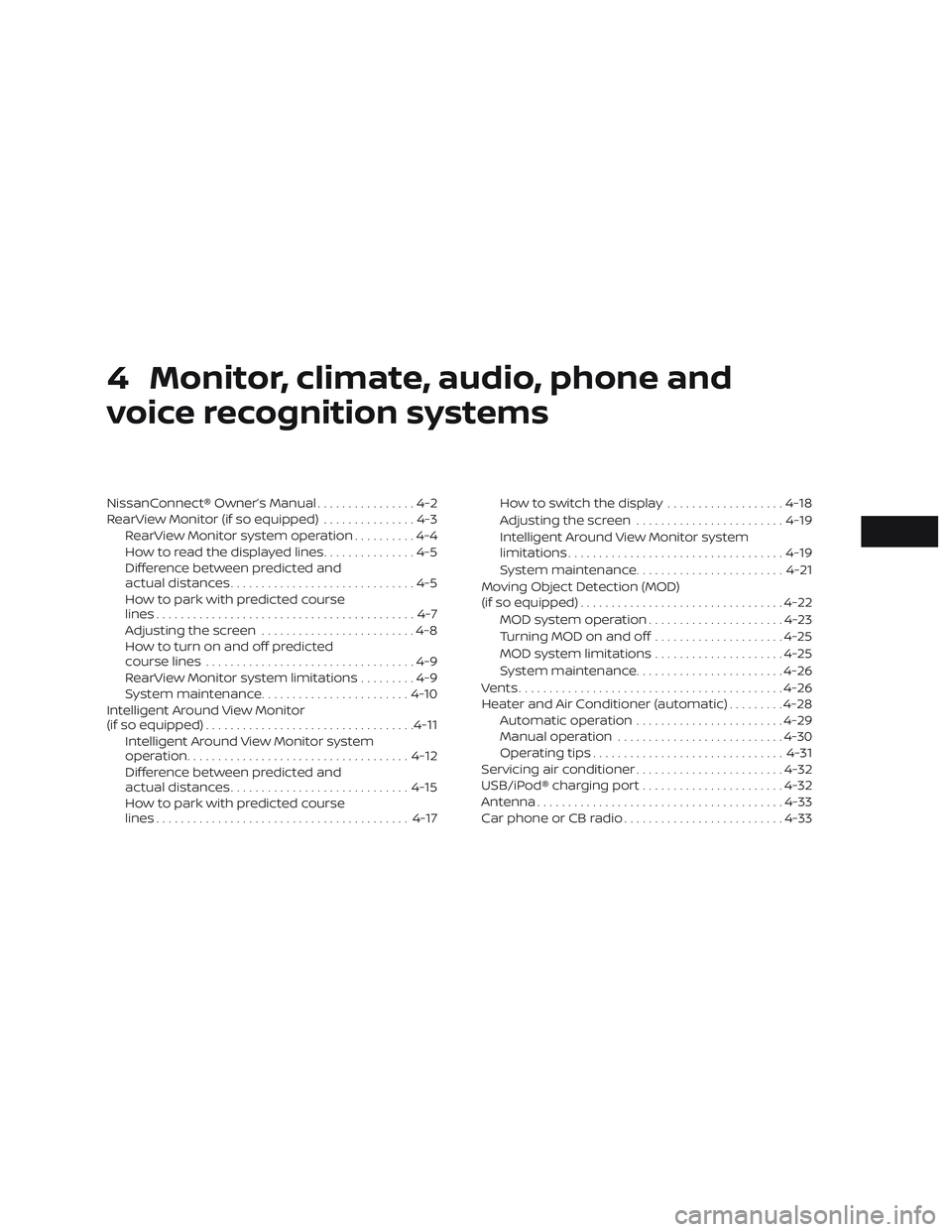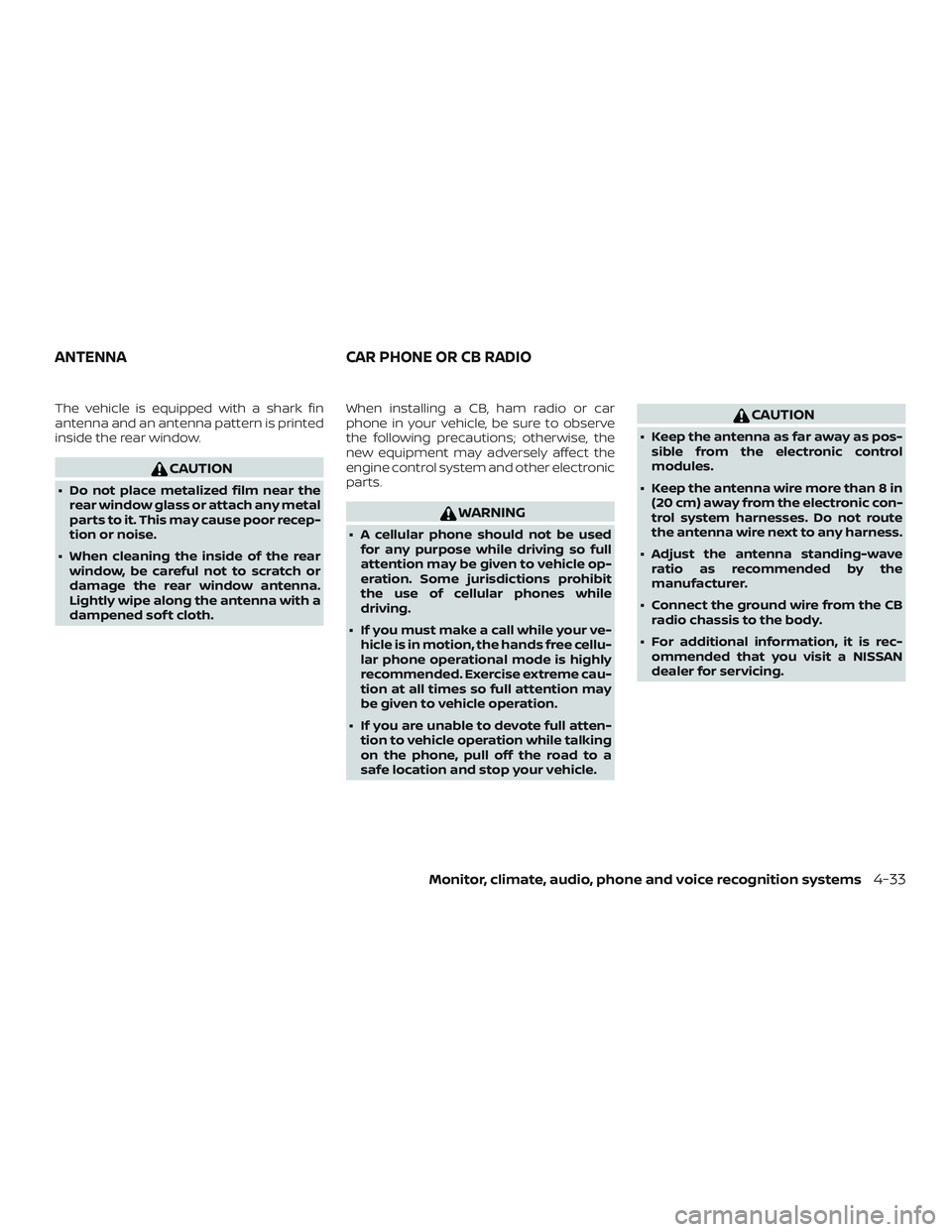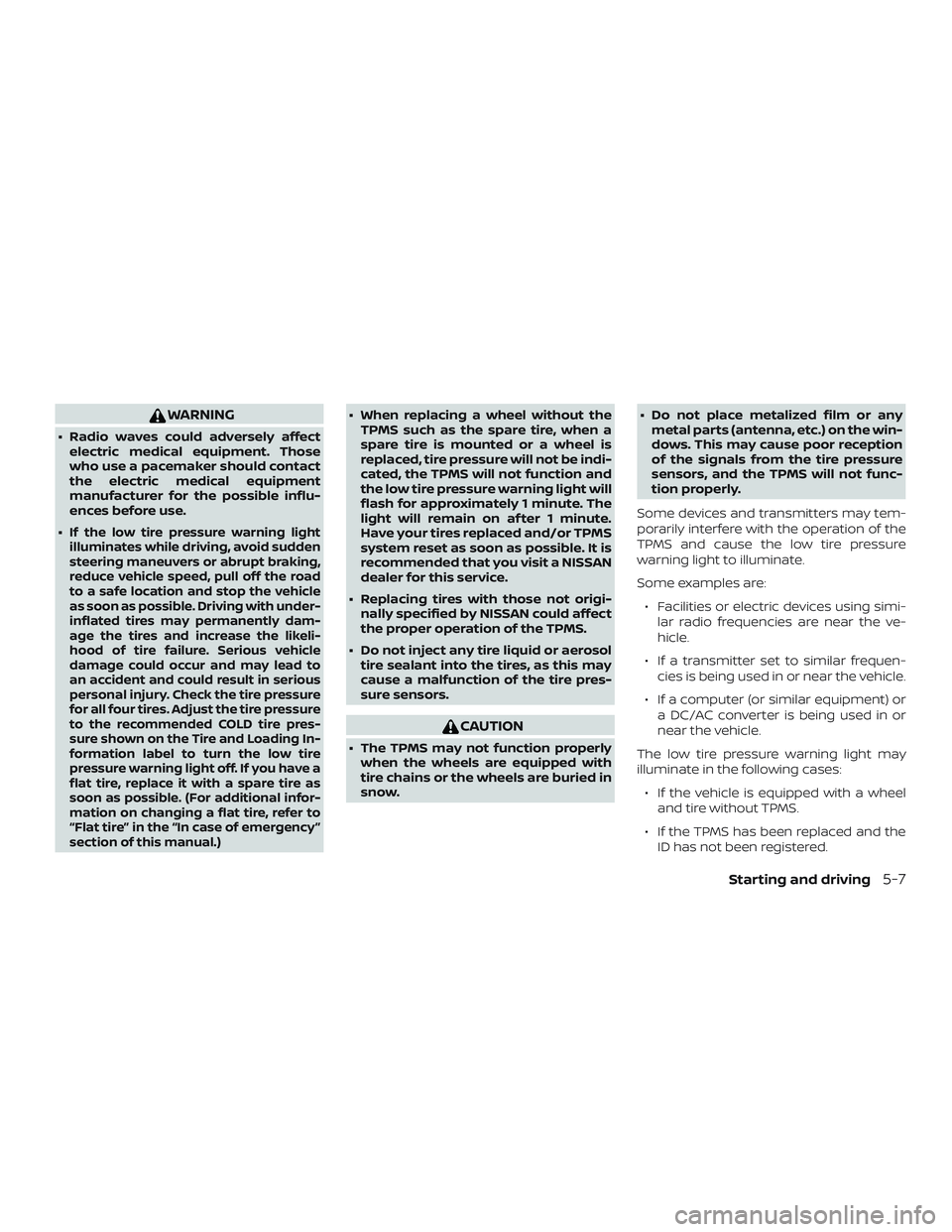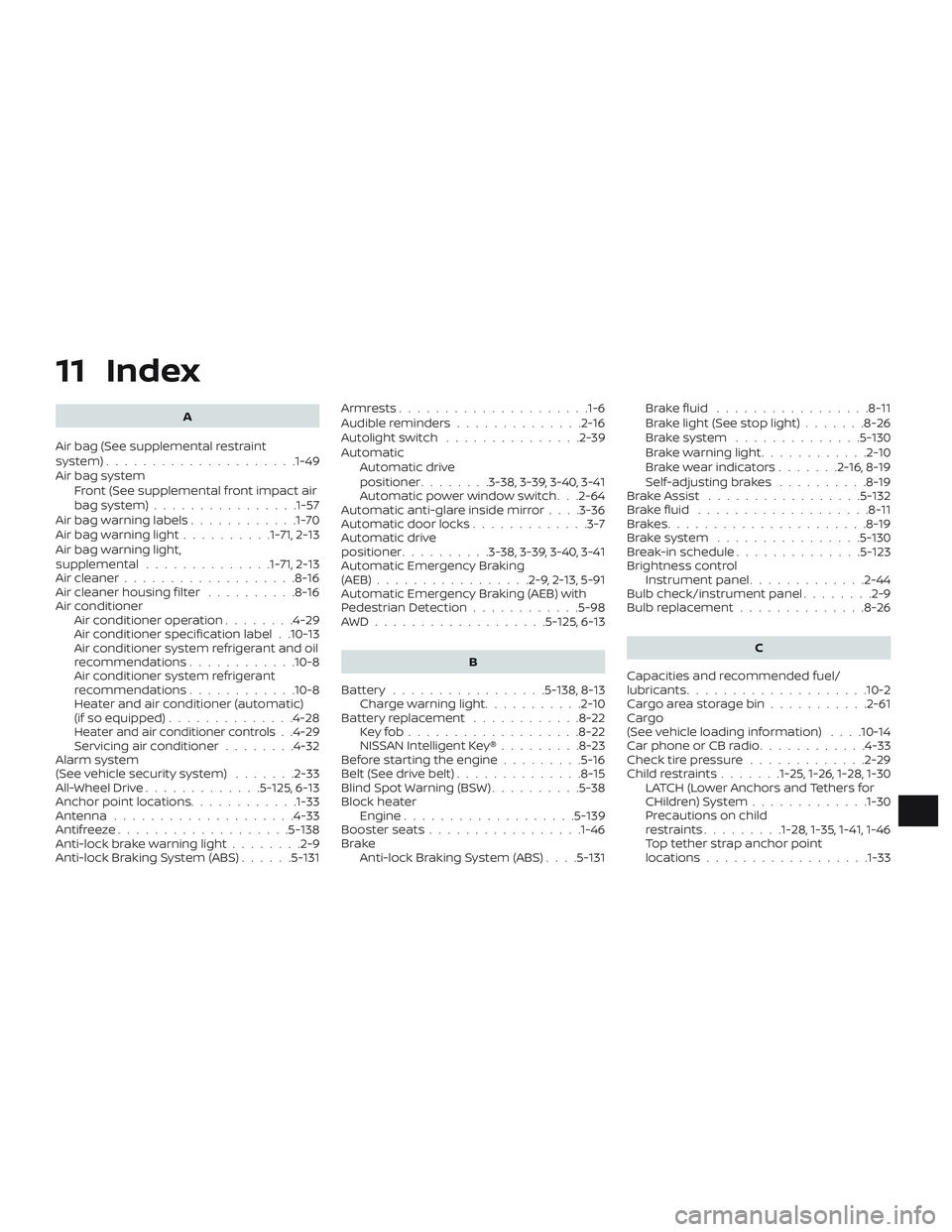2019 NISSAN MURANO radio antenna
[x] Cancel search: radio antennaPage 213 of 507

4 Monitor, climate, audio, phone and
voice recognition systems
NissanConnect® Owner’s Manual................4-2
RearView Monitor (if so equipped) ...............4-3
RearView Monitor system operation ..........4-4
How to read the displayed lines ...............4-5
Difference between predicted and
actual distances ..............................4-5
How to park with predicted course
lines ..........................................4-7
Adjusting the screen .........................4-8
How to turn on and off predicted
course lines ..................................4-9
RearView Monitor system limitations .........4-9
System maintenance ........................ 4-10
Intelligent Around View Monitor
(if so equipped) .................................. 4-11
Intelligent Around View Monitor system
operation .................................... 4-12
Difference between predicted and
actual distances ............................. 4-15
How to park with predicted course
lines ......................................... 4-17How to switch the display
...................4-18
Adjusting the screen ........................ 4-19
Intelligent Around View Monitor system
limitations ................................... 4-19
System maintenance ........................ 4-21
Moving Object Detection (MOD)
(if so equipped) ................................. 4-22
MOD system operation ......................4-23
Turning MOD on and off .....................4-25
MOD system limitations .....................4-25
System maintenance ........................ 4-26
Vents ........................................... 4-26
Heater and Air Conditioner (automatic) .........4-28
Automatic operation ........................ 4-29
Manual operation ........................... 4-30
Operating tips ............................... 4-31
Servicing air conditioner ........................4-32
USB/iPod® charging port .......................4-32
Antenna ........................................ 4-33
Car phone or CB radio .......................... 4-33
Page 245 of 507

The vehicle is equipped with a shark fin
antenna and an antenna pattern is printed
inside the rear window.
CAUTION
∙ Do not place metalized film near therear window glass or attach any metal
parts to it. This may cause poor recep-
tion or noise.
∙ When cleaning the inside of the rear window, be careful not to scratch or
damage the rear window antenna.
Lightly wipe along the antenna with a
dampened sof t cloth. When installing a CB, ham radio or car
phone in your vehicle, be sure to observe
the following precautions; otherwise, the
new equipment may adversely affect the
engine control system and other electronic
parts.
WARNING
∙ A cellular phone should not be used
for any purpose while driving so full
attention may be given to vehicle op-
eration. Some jurisdictions prohibit
the use of cellular phones while
driving.
∙ If you must make a call while your ve- hicle is in motion, the hands free cellu-
lar phone operational mode is highly
recommended. Exercise extreme cau-
tion at all times so full attention may
be given to vehicle operation.
∙ If you are unable to devote full atten- tion to vehicle operation while talking
on the phone, pull off the road to a
safe location and stop your vehicle.
CAUTION
∙ Keep the antenna as far away as pos-sible from the electronic control
modules.
∙ Keep the antenna wire more than 8 in (20 cm) away from the electronic con-
trol system harnesses. Do not route
the antenna wire next to any harness.
∙ Adjust the antenna standing-wave ratio as recommended by the
manufacturer.
∙ Connect the ground wire from the CB radio chassis to the body.
∙ For additional information, it is rec- ommended that you visit a NISSAN
dealer for servicing.
ANTENNA CAR PHONE OR CB RADIO
Monitor, climate, audio, phone and voice recognition systems4-33
Page 253 of 507

WARNING
∙ Radio waves could adversely affectelectric medical equipment. Those
who use a pacemaker should contact
the electric medical equipment
manufacturer for the possible influ-
ences before use.
∙
If the low tire pressure warning light
illuminates while driving, avoid sudden
steering maneuvers or abrupt braking,
reduce vehicle speed, pull off the road
to a safe location and stop the vehicle
as soon as possible. Driving with under-
inflated tires may permanently dam-
age the tires and increase the likeli-
hood of tire failure. Serious vehicle
damage could occur and may lead to
an accident and could result in serious
personal injury. Check the tire pressure
for all four tires. Adjust the tire pressure
to the recommended COLD tire pres-
sure shown on the Tire and Loading In-
formation label to turn the low tire
pressure warning light off. If you have a
flat tire, replace it with a spare tire as
soon as possible. (For additional infor-
mation on changing a flat tire, refer to
“Flat tire” in the “In case of emergency ”
section of this manual.)
∙ When replacing a wheel without the TPMS such as the spare tire, when a
spare tire is mounted or a wheel is
replaced, tire pressure will not be indi-
cated, the TPMS will not function and
the low tire pressure warning light will
flash for approximately 1 minute. The
light will remain on af ter 1 minute.
Have your tires replaced and/or TPMS
system reset as soon as possible. It is
recommended that you visit a NISSAN
dealer for this service.
∙ Replacing tires with those not origi- nally specified by NISSAN could affect
the proper operation of the TPMS.
∙ Do not inject any tire liquid or aerosol tire sealant into the tires, as this may
cause a malfunction of the tire pres-
sure sensors.
CAUTION
∙ The TPMS may not function properlywhen the wheels are equipped with
tire chains or the wheels are buried in
snow. ∙ Do not place metalized film or any
metal parts (antenna, etc.) on the win-
dows. This may cause poor reception
of the signals from the tire pressure
sensors, and the TPMS will not func-
tion properly.
Some devices and transmitters may tem-
porarily interfere with the operation of the
TPMS and cause the low tire pressure
warning light to illuminate.
Some examples are: ∙ Facilities or electric devices using simi- lar radio frequencies are near the ve-
hicle.
∙ If a transmitter set to similar frequen- cies is being used in or near the vehicle.
∙ If a computer (or similar equipment) or a DC/AC converter is being used in or
near the vehicle.
The low tire pressure warning light may
illuminate in the following cases: ∙ If the vehicle is equipped with a wheel and tire without TPMS.
∙ If the TPMS has been replaced and the ID has not been registered.
Starting and driving5-7
Page 499 of 507

11 Index
A
Air bag (See supplemental restraint
system) .................... .1-49
Air bag system Front (See supplemental front impact air
bagsystem)................1-57
Air bag warning labels ............1-70
Airbagwarninglight..........1-71, 2-13
Air bag warning light,
supplemental ..............1-71, 2-13
Air cleaner ...................8-16
Air cleaner housing filter ..........8-16
Air conditioner Air conditioner operation ........4-29
Air conditioner specification label . .10-13
Air conditioner system refrigerant and oil
recommendations ............10-8
Air conditioner system refrigerant
recommendations ............10-8
Heater and air conditioner (automatic)
(if so equipped) ..............4-28
Heater and air conditioner controls. .4-29
Servicing air conditioner ........4-32
Alarm system
(See vehicle security system) .......2-33
All-Wheel Drive .............5-125,6-13
Anchor point locations ............1-33
Antenna ....................4-33
Antifreeze ...................5-138
Anti-lock brake warning light ........2-9
Anti-lock Braking System (ABS) ......5-131Armrests....................
.1-6
Audible reminders ..............2-16
Autolightswitch ...............2-39
Automatic Automatic drive
positioner ........3-38,3-39,3-40,3-41
Automatic power window switch . . .2-64
Automatic anti-glare inside mirror . . . .3-36
Automatic door locks .............3-7
Automatic drive
positioner ..........3-38,3-39,3-40,3-41
Automatic Emergency Braking
(AEB) .................2-9,2-13,5-91
Automatic Emergency Braking (AEB) with
Pedestrian Detection ............5-98
AWD...................5-125,6-13
B
Battery .................5-138,8-13 Charge warning light ...........2-10
Battery replacement ............8-22
Keyfob...................8-22
NISSAN Intelligent Key® .........8-23
Before starting the engine .........5-16
Belt(Seedrivebelt)..............8-15
Blind Spot Warning (BSW) ..........5-38
Block heater Engine ...................5-139
Booster seats .................1-46
Brake Anti-lock Braking System (ABS) ....5-131Brakefluid .................8-11
Brakelight(Seestoplight).......8-26
Brakesystem ..............5-130
Brakewarninglight............2-10
Brakewearindicators.......2-16,8-19
Self-adjustingbrakes ..........8-19
Brake Assist .................5 -132
Brakefluid ...................8-11
Brakes......................8-19
Brakesystem ................5-130
Break-in schedule ..............5-123
Brightness control Instrument panel .............2-44
Bulb check/instrument panel ........2-9
Bulb replacement .............. 8-26
C
Capacities and recommended fuel/
lubricants....................10-2
Cargoareastoragebin...........2-61
Cargo
(See vehicle loading information) . . . .10-14
Car phone or CB radio ............4-33
Check tire pressure .............2-29
Childrestraints.......1-25, 1-26, 1-28, 1-30 LATCH (Lower Anchors and Tethers for
CHildren)System.............1-30
Precautions on child
restraints.........1-28, 1-35, 1-41, 1-46
Top tether strap anchor point
locations..................1-33